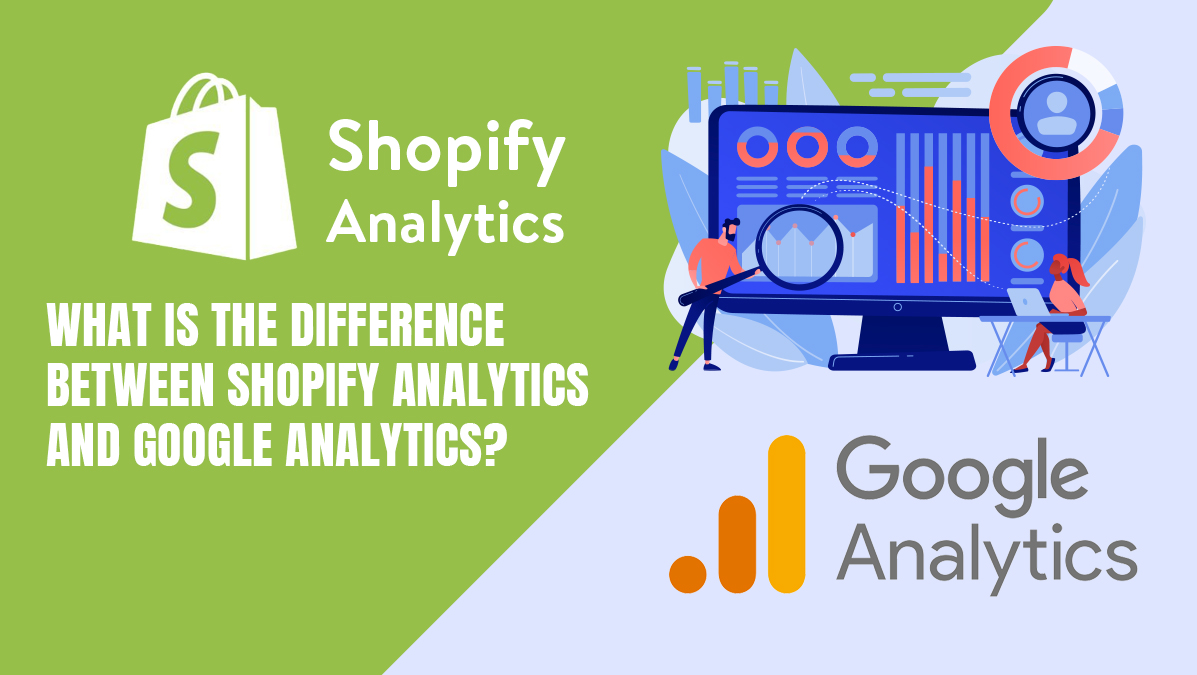When it comes to the world of eCommerce, gaining valuable insights into customer behaviour and optimising business strategies rely heavily on data-driven analysis. Two powerful tools in this regard are Shopify Analytics and Google Analytics. While both platforms aim to track and analyse data, there exist significant differences between the two.
When faced with conflicting data from Shopify and Google Analytics regarding your Shopify store, it can be confusing to determine which source is the most accurate and reliable. This situation calls for a thorough comparison of Shopify Analytics and Google Analytics to identify the superior option.
In this in-depth analysis of Shopify Analytics vs Google Analytics, it becomes evident that Google Analytics surpasses Shopify in various aspects, providing a greater depth of detail.
Let’s explore the advantages of Google Analytics that are absent in Shopify Analytics.
Shopify Analytics: Overview
Shopify is a prominent e-commerce platform that offers a range of services, including analytics. However, it is crucial to understand the extent of data monitored by Shopify Analytics and evaluate whether Google Analytics offers a superior alternative.
Metrics Tracked on Shopify
- Dashboards: The dashboard itself is not a metric but rather a display of key metrics that track visitor behaviour. This numerical and graphical representation includes:
- Total Sales: Revenue generated through merchandise sales.
- Online Sessions: The number of times visitors explore the store and their activities during the visits.
- Customer Return Rate: Presented as a percentage.
- Customer’s Conversion Rate: Percentage of sessions resulting in orders out of the total sessions.
- Average Order Value: Total order value divided by the number of orders.
- Total Number of Orders: Shows the number of customers who returned to the Shopify store over time and made repeat purchases.
- Additional reports cover total orders, total products sold, sessions by location, sessions by traffic source, sessions by device type, sessions by social source, top landing pages by sessions, top referrers by session, and sales attributed to marketing.
- Reports: Shopify reports are accessible to users with the Basic Shopify plan or higher. These reports cover inventory, finances (taxes, incoming and outgoing payments), visitor behaviour, marketing statistics, and sales. While they provide useful insights into store activity, they are not comprehensive enough to replace e-commerce analytics entirely. Moreover, the limitation that certain reports are only available on more expensive plans is a drawback for those seeking affordable and detailed analytics.
- Live View: Shopify’s Live View tool enables real-time monitoring of store activity, including the number of current visitors and their actions. Additional metrics that the page provides include:
- Current Visitors
- Totals from Today
- Current Customer Behaviour on Your Store
- Real-time Pageviews
- Report Customisation – In addition to standard reports, Shopify allows you to customise the standard report as per your requirements. But the only limitation is that you can only add the metrics tracked by Shopify. You cannot measure any custom parameter in Shopify Analytics.
Note: Despite the availability of numerous metrics on Shopify reports, their usefulness is questionable, particularly when compared to Google Analytics. Google Analytics possesses more comprehensive information about store visitors, including how they found the store, their duration of use, their actions, and their subsequent activities.
Should You Rely Entirely on Shopify Analytics
There are several reasons why Shopify Analytics should not be solely relied upon:
- Platform Dependency: If you decide to switch from Shopify to another e-commerce platform in the future, you will lose all your analytic data. However, with Google Analytics, starting from the beginning allows for seamless data transition.
- Plan-Specific Data: Certain reports on Shopify are only accessible with higher-end plans. This restricts the level of detail and affordability for users seeking cost-effective analytics.
- Lack of Cross-Domain Tracking: Unlike Google Analytics, Shopify Analytics does not offer cross-domain tracking. This means that data from two related domains cannot be compared, which can be a significant drawback for users running multiple interconnected websites.
- Custom Events and Parameters: While custom events and parameters in Shopify Analytics provide valuable insights and flexibility, there are certain limitations to consider. One limitation is the technical implementation required to set up and track custom events and parameters effectively. It may require developer resources or advanced knowledge of JavaScript and Shopify Liquid code. Additionally, the data captured through custom events and parameters is limited to the scope of the Shopify Analytics platform, which means it may not integrate seamlessly with other analytics tools or platforms. Finally, the analysis and reporting of custom events and parameters in Shopify Analytics are restricted to the capabilities provided within the platform, which may not offer the same level of advanced analysis as specialized analytics tools.
Advantages of Google Analytics over Shopify Analytics
When comparing Shopify vs Google Analytics, Google outperforms Shopify in multiple areas. The key distinction lies in the breadth of metrics tracked. Let’s explore the metrics that Google Analytics offers but are not available in Shopify Analytics.
Metrics Tracked on Google Analytics Exclusively
- Lifetime Value (LTV): Tracking the Lifetime Value of users is crucial for online retailers. This metric allows you to determine how much each user has contributed to your company and through which channels. Utilise this data to refine your marketing strategies and target your most valuable customers effectively.
- Total Sessions vs. Unique Sessions: Google Analytics distinguishes between total sessions and unique sessions. Total sessions represent the number of times a user accessed your site and engaged with it, regardless of the duration. Unique sessions, also known as unique pageviews, reveal how many times a specific page was accessed and by whom. These sessions provide insights into the popularity and success of individual pages, enabling targeted improvements.
- Real-Time Reporting with Greater Depth: While Shopify Analytics offers a live view with limited metrics (visitors, sessions, shopping cart activity, and daily sales totals), Google Analytics provides more comprehensive real-time reporting, including:
- Specific pages being accessed in real-time
- Percentage of active users on those pages
- Time comparisons between direct and organic visitors
- Referring keywords
- Real-time completion of Google Analytics goals
- Conversions
- Seamless Integration with Other Marketing Tools: Google Analytics seamlessly integrates with various marketing tools, such as:
- Google Ads: Monitor the success of ad campaigns, a feature absent in Shopify Analytics.
- Google Search Console: Analyse crawling and indexing issues, as well as view search traffic and keywords leading users to your store.
- Third-party applications: Google Analytics offers seamless integration with numerous third-party marketing tools, making it compatible with a wide range of preferred platforms.
- Accurate Assessment of Conversion Rate: While Shopify Analytics can also track conversion rates, Google Analytics calculates rates based on a more extensive set of variables. This enables a more accurate assessment of your true conversion rate.
- Setting eCommerce Goals: Google Analytics allows the setting of eCommerce goals, such as form sign-ups or product purchases. These goals are monitored in real-time, providing valuable insights into daily store performance.
- Enhanced eCommerce Tracking: Google Analytics excels in customer monitoring, encompassing cart abandonment, bounce rate, and overall customer behaviour throughout the purchasing process. These insights empower you to optimize your store based on the behaviour of your most profitable customers, a level of granularity not achievable with Shopify Analytics.
- Conclusion: Shopify vs Google Analytics
To harness a cutting-edge data-tracking system and maximise online profits, placing your trust in Google Analytics is highly recommended. Its comprehensive metrics, seamless integration with other marketing tools, and valuable insights into customer behaviour outshine the capabilities of Shopify Analytics.
Ready to enhance your business with Google Analytics? Contact 18th DigiTech, the best SEO company in India, for personalized guidance and seamless implementation.












